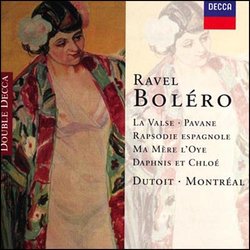| All Artists: Maurice Ravel, Charles Dutoit, Montréal Symphony Orchestra Title: Ravel: Bol�ro Members Wishing: 0 Total Copies: 0 Label: Decca Original Release Date: 1/1/1999 Re-Release Date: 11/9/1999 Genre: Classical Styles: Ballets & Dances, Ballets, Historical Periods, Modern, 20th, & 21st Century, Symphonies Number of Discs: 2 SwapaCD Credits: 2 UPC: 028946021422 |
Search - Maurice Ravel, Charles Dutoit, Montréal Symphony Orchestra :: Ravel: Bol�ro
 | Maurice Ravel, Charles Dutoit, Montréal Symphony Orchestra Ravel: Bol�ro Genre: Classical
|
Larger Image |
CD Details |
CD ReviewsNo better recordings at any price D. Roth | Pleasant Hill, Ca | 07/08/2000 (5 out of 5 stars) "It was the best of all possible conditions... A dedicated regional orchestra with an ambitious experienced conductor; an incredibly fine recording site, St. Eustache, which combined a vibrant, resonant glow with razor sharp detail; and a technically accomplished record company looking for a new,fresh team to present Franco-Russian orchestral works in digital sound.These Ravel recordings were among the first and most dazzling results of the Decca/Montreal/Dutoit team. The tempi are so aptly chosen and sustained that you don't even get the sensation of the music moving fast or slow, just unfolding( the opening of Alborada del Gracioso is a great example). The soloists and orchestral choirs articulate with elegance but also with a haunting suppleness and freedom( the english horn solo in part three of Rhapsody Espagnole). And the sound is still exceptionally beautiful, actually enhancing the orchestra's image in loud, densly scored passages. The only disappointment is the inclusion of the suite from Daphnis and Chloe rather than the stupendous complete ballet-their first recording. The complete ballet has been issued on the Legends series and is worth the purchase.There are many fabulous performances of these great works from Boulez, Reiner, Cluytens, Munch, Martinon, etc; This is a great value and a perfect place to start." A box of goodies jhorro | VA | 07/08/2001 (5 out of 5 stars) "Dutoit's recordings of Ravel's major orchestral works made a name for the Montreal Symphony. Everything on this set maintains a high level of quality, both in interpretation and recording. There is flexibility, refinement of orchestral color, and atmosphere. The Mother Goose suite is matchless in its innocence and beauty. The Bolero is a demonstration item, although it too has subtlety. The excerpt from Daphnis et Chloe is magical - this is some of the most impressive blending of orchestral sonority on record. Not to be missed." You never have enough Ravel - just never. Craig Matteson | Ann Arbor, MI | 01/14/2006 (5 out of 5 stars) "This two disk set is one of those that you should add to your collection because it is wonderful music, sounds great, and is extremely affordable. Everyone knows and loves "Boléro". Commissioned by Ida Rubinstein as a ballet and premiered in 1928 was not a musical success. At another performance, led by Toscanini, Ravel complained that the tempo was too fast. Toscanini replied that it was the only way to save the work. But it soon became a mass success to Ravel's surprise and consternation. He felt they loved it for all the wrong reasons. The violinist Hélène Jourdan-Morhange relates this interesting story of one incident involving the work:
"Ravel was extremely surprised at the mass success of "Boléro" `They're going to turn it into another "Madelon", he said, rather crossly; and deep down he felt that the obsessive, musico-sexual element in the piece was probably behind its enormous popularity. But one old lady was proof against the contagion. Ravel's brother Edouard saw her, at the first performance, wedged tightly in her seat shouting above the applause `Rubbish! Rubbish!' Maurice, when informed by his brother, replied mysteriously: `That Old Lady got the message!'" from Ravel et nous 1945 page 166. The other works on this disk are more substantive than the 15-minute crescendo and its constantly changing orchestral colors. The entire "Mother Goose" ballet - who doesn't love this? Although you usually here it performed as the suite. The "Rhapsodie Espagnol" is a favorite and delivers that wonderful Spanish flavor with a French sauce. "Le tombeau de Couperin" and "Valses nobles et sentimentale" are orchestrations of major piano works (with some alterations in the tombeau) (there are other pieces on these disks that also began as piano works) that are probably more well known to the general public as orchestral works. However, they are very essential works in the pianist's repertoire, and I encourage you to get to know them in that form as well. "La Valse" is really two things. There is a tribute to Johann Strauss. Ravel admitted that every composer wanted to write a very good waltz, but that it was very difficult. So, he wrote this symphonic waltz as a tribute. However, the second half is something else, is it not? There is decadence and a madness to it that seems like a nightmare to me. As if we are all trapped in this thing until everything falls apart with pain and loss into nothing. A fascinating piece. There are other small and popular pieces on this disk that are all done well. Recommended!" |

 Track Listings (10) - Disc #1
Track Listings (10) - Disc #1